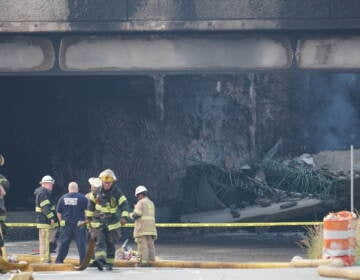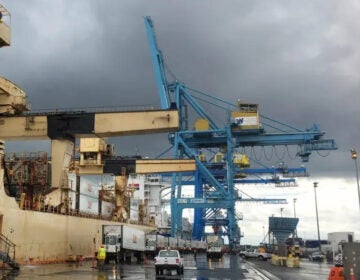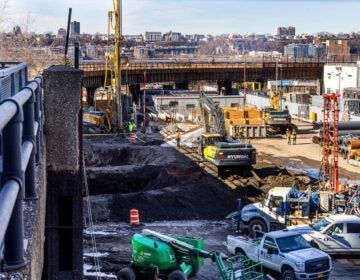Porteños tour the Delaware

Photos by Isaac Steinberg for PlanPhilly
June 16
By Kellie Patrick Gates
For PlanPhilly
Quilmes City Mayor Francisco Gutierrez walked beside the Delaware River on a new trail that skirts a capped-off, former landfill.
The fresh air, the soccer and baseball fields and the man fishing from the bank all seemed to be hopeful signs for his city, which lies along the Rio de la Plata in Buenos Aires Province, Argentina.
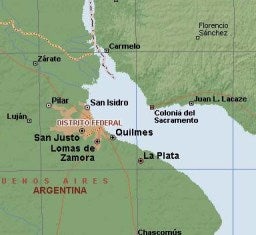
Guiterrez and about 30 other representatives from government agencies, planners and community activists from his region visited here last week to see Philadelphia’s still-developing answer to a problem that their region also faces. They, too, want to reclaim waterfront land – often former industrial sites laced with pollutants – and reconnect their cities to their river.
“Many cities abandoned the river because the water was contaminated,” Gutierrez said through interpreter Elizabeth Caruso. The public wants the river back, he said. “Cities need open places,” he said.
But now, just as in Philadelphia, their neighborhoods are cut off from a natural resource that could provide space for recreation – and an economic boost through residential and economic development.
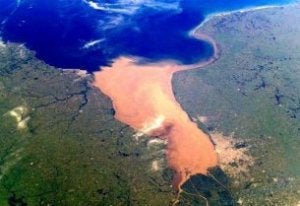
Reconnecting to the wide expanse of Rio de la Plata – the Silver River – is “central” to Quilmes’ future, Gutierrez said. And “The project here in Philadelphia, along the entire coast of the river’s edge – the idea is very similar to ours. We will use your experience.”
The tour was led by the Delaware River City Corporation – a non-profit organization that is developing the North Delaware Riverfront Greenway Trail. The trail, now under construction, will eventually run eight miles from Pulaski Park to Glen Foerd. The idea is to help revitalize Northeast Philadelphia by reconnecting it to the river. Plans call for a multi-use trail, and also residential and retail space.
Guiterrez and the rest of the group walked along the river at Pennypack Park. They toured the Navy Yard, where they saw how buildings that were part of the Navy’s large Philadelphia presence until the 1990s base closings were being restored and reused by businesses as diverse as ship-building company Aker and clothing retailer Urban Outfitters.
They also drove through the Packer Park residential development, built on land contaminated by a nearby refinery, after a vapor-barrier was put under three feet of clean soil to keep the fumes away from residents.
“You can’t grow vegetables here, but you can live here in a safe neighborhood,” said Paul Lonie, the DRCC’s Capital Program Director who once worked for Westrum Development.
“These houses sold for $200,000 when they were built. Now they sell for $400,000.”
Ernesto Mario Rona, personal director for the Techint Group – a consortium of companies based in Buenos Aires – helped organize the tour. One of the Techint companies owns 400 acres along Rio de la Plata, where it hopes to create, essentially, a new city with many homes, commercial space, a university, a convention center, hotels and public green space with a trail near the river.
After doing some internet research, Techint discovered that Philadelphia and New York, were in various stages of work on similar issues, and the tour was arranged, Rona said. The day prior to coming to Philadelphia, the group visited the former Fresh Kills landfill, in Staten Island. New York has begun a 20-year project aimed at transforming Fresh Kills into public park space and reclaimed wetlands.
Rona said the visit was beneficial. “It is difficult to imagine how to change the things we want to change looking at the place,” he said. “It is better to come to places where this is already taking place, to show it can be done.”
Rona said the land his company owns has never been developed, but it is bordered by problem areas. “Behind our land is a landfill,” he said. “The landfill is closed, but we have to find a way to fix it. There’s no bad smell now, but things can be done to improve the safety.” There is also an adjacent canal – essentially a sewer, Rona said – that is highly polluted. And a smaller river that leads into the Rio de la Plata also must be cleaned up.
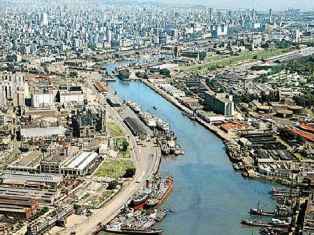
For the project to happen, many levels of government and governmental agencies must work together, he said. Community support is essential, and, like here, riverfront development is highly regulated. “We need permits,” Rona said. They hope to begin work sometime next year.
Technit CFO Eduardo A. Russo said the initial investment, to be shared by his company and two cities, a province, and the nation, would total several hundred million dollars. After that, it is hoped that other companies would invest and develop the new city, which would take between seven and 10 years to complete, he said.
The biggest obstacle, Mayor Gutierrez said, “is the same everywhere in the world – money.”
Tour-goer Marcela Adriani is president of a non-governmental agency called The Mothers of the Towers. She said the project has residents’ support.
“We’ve been working on this for nine years,” she said through translator Caruso.
Her group takes its name from the apartment towers that are 500 meters from the landfill that is behind the riverfront property where development is proposed – between it and the neighborhoods.
“Our children had problems because of this (landfill), and we got them to close the landfill,” she said. There was a huge fire in the landfill in 1999, and afterward, tower residents discovered many children living in the towers had leukemia. The World Health Organization told the Mothers that the normal incidence of leukemia is 1 in 10,0000 people. Twelve thousand residents live in the towers, Adriani said, and 22 children had leukemia. The landfill was closed in 2004, and since then, Adriani said, there have been no new cases.
“We want them to develop the whole waterfront, preserving the areas of public access for paths – walking paths and bike paths, similar to what you have here.” Adriani said. “We want the project to go forward, to revitalize the whole area,” she said, adding that her group would watch carefully to make sure environmental issues were handled properly.
Contact the reporter at kelliespatrick@gmail.com
WHYY is your source for fact-based, in-depth journalism and information. As a nonprofit organization, we rely on financial support from readers like you. Please give today.




